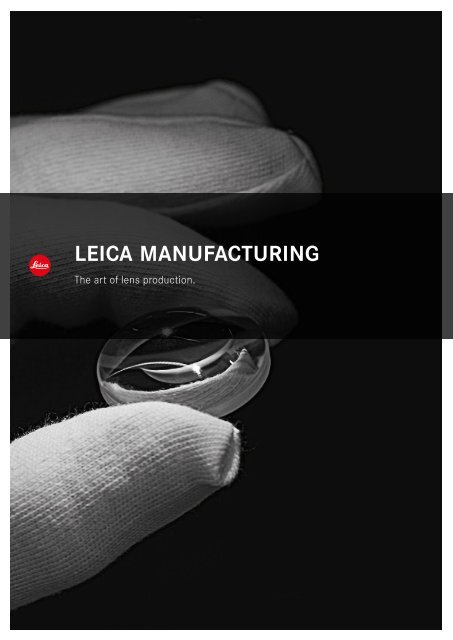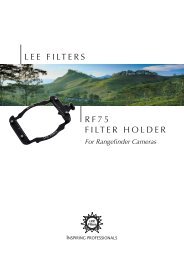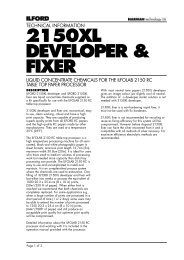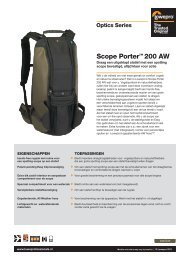LEICA MANUFACTURING
LEICA MANUFACTURING
LEICA MANUFACTURING
You also want an ePaper? Increase the reach of your titles
YUMPU automatically turns print PDFs into web optimized ePapers that Google loves.
<strong>LEICA</strong> <strong>MANUFACTURING</strong>The art of lens production.
<strong>LEICA</strong> <strong>MANUFACTURING</strong>The art of lens construction.Dear Photographer,Leica Camera shares your passion for creative, sophisticated photography. For us, the most important factor is toguarantee superior image quality and maximum creative freedom. And for almost a century, this has been Leica’saim in the development of its cameras and lenses. As in the past, true masterpieces today are produced by handin high-tech laboratories within the Leica factory, with the ultimate goal of being regarded by photographers as thebest in the world. A combination of relentless precision, inexhaustible innovation, highly specialised expertise andabsolute passion, not to mention invaluable experience, results in products of unrivalled excellence and quality.Within this brochure, we hope to demonstrate the extraordinary levels of dedication and passion that go into themanufacturing of Leica products today.Yours,Leica Camera AGEvery single Leica lens is constructed with absolute precision in a meticulous manual process.<strong>LEICA</strong> <strong>MANUFACTURING</strong> I 03
L E I C ALENSESEach with its own unique talents.Even the best camera can be let down if its optical performance does not meet the photographer’s standards. Thisis why M-Lenses fulfil even the highest expectations. Each lens is the result of more than 150 years of expertise andexperience in the design and construction of optical instruments. Every single lens must pass through numerousprocesses and quality assurance procedures, pass inspection by the discerning eyes of experts, and satisfy thecriteria of exhaustive precision testing. No wonder that Leica lenses, which are ‘Made in Germany’, have become asynonym for quality. Not least because the quality that Leica demands has always been, and will always be, onething: uncompromising.HIGH-QUALITY GLASSThe first thing in the life of every lens is the choice of glass. Purity, as well asits reflective, refractive and transmission characteristics, can influenceimage quality from the start. Only the best optical glass is selected for themanufacture of Leica lenses. For the current lens portfolio, Leica needsaround 100 different types of glass for the production of approximately360 different lens elements. Our own glass laboratory, founded in 1948,formulated and patented many of these types of glass. Today, researchand development in the Leica glass laboratory continues to ensure thehighest quality: hundreds of glass types and test reports are immediatelyavailable for computer simulations and practical testing.OUTSTANDINGLY FASTThe high transmission characteristics of all Leica lenses guaranteeoutstanding maximum apertures. Enormous effort is also invested inthe minimisation of stray light around the lens elements and in the lensbarrel by precision coating and perfected barrel construction. All glasssurfaces are treated with high-performance antireflex coatings that aredetermined separately for each glass type using geometrical calculationsbased on all optical correction parameters. At Leica, the search for opticalexcellence is a passion. In their search, Leica engineers find not only thebest solutions for guiding light, but also the most elegant.EXCEPTIONAL IMAGING PERFORMANCETo build the perfect lens, the laws of physics must be rewritten. Lawsthat also apply to Leica. Nevertheless, Leica engineers constantly striveto push the limits of the technically possible. A rewarding approach:M-Lenses have a very even imaging performance across the entire imagefield. There is no vignetting, and they are almost entirely free of aberration,yet they offer high colour saturation and precise colour separation.MECHANICAL PRECISIONThe best optical system will only demonstrate such performance qualitiesif the engineering of the lens barrel is just as precise. Depending on thelens, the effects of at least 50 construction parameters on imagingperformance must be perfectly coordinated. Engineering with suchprecision is only possible by combining the latest technologies with themost meticulous manual skills, and naturally, in combination with only thehighest-quality materials. Thanks to perfect functionality, intelligentconstruction and an absolute dependability that guarantees perfecthandling at temperatures from –25°C to +60°C, every single Leica M-Lensis a unique masterpiece of manual precision.ASPHERICAL LENS ELEMENTSThe majority of M-Lenses feature aspherical elements. In contrast to thesymmetrical curvature of spherical lenses, their surfaces are characterisedby asymmetry. This makes it possible to refract light rays at the edgesof the lens element differently to those passing through its centre. Thismeans that a single lens element can simultaneously perform severalcorrections. It is precisely this curvature that makes the production ofsuch lens elements so elaborate. But the complex calculations arerewarding: aspherical surfaces minimise or avoid aberrations and are alsothe key to the compact size of M-Lenses.04 I <strong>LEICA</strong> LENSES<strong>LEICA</strong> LENSES I 05
L E I C ALENSESA synonym for quality that is ‘Made in Germany’It takes more than 30 processes to assemble around 100 individual components that make up an M-Lens.However, perfect tools can only be produced if components and sub-assemblies are painstakingly checked duringproduction. Depending on the type, a lens therefore passes through up to 60 quality checks during assembly. Onlywhen an M-Lens satisfies all criteria may it pass from the clean room to the quality assurance testing facility. There,every lens must pass numerous empirical tests and the most stringent functional checks – in six comprehensivetesting facilities. Only perfect Leica lenses ultimately receive the inspection certificate as confirmation of their uniquequality.3 INTERNAL VISUAL INSPECTIONThis step serves as a check to ensure that no dust, coating defects orother flaws are present inside the lens. Here, a light is viewed throughthe lens from both ends to reveal even the smallest dust particles onlens element surfaces or lens barrel components. At the same time,coating defects can be revealed by irregularities in the shimmeringcolours reflected from coated lens elements.4 EXTERNAL VISUAL INSPECTIONThis phase of checking involves all external surfaces of the lens. If theseare flawless, and all smooth surfaces, knurled components and edgesare faultlessly chromed, anodised or painted, the engraving can now beinspected. Only when these are also perfectly finished, with smooth,precisely painted edges, can the lens be passed to the next phase ofquality assurance.5 TESTING OF MECHANICAL FUNCTIONS1 MTF ANALYSISEach lens may be considered in terms of two main assemblies – the’focusing mount‘ and the ’lens head’. The latter contains the entireoptical system that is tested after final assembly on a ModulationTransfer Function (MTF) system. An electronic camera captures theimage of a back-illuminated slit with a width of only ten microns. Theresult of this enables the determination of contrast rendition and imagefield curvature. Both allow extremely accurate conclusions to be madeabout image performance and, in turn, the correct assembly of the lens.2 INFINITY CALIBRATIONThe aim of this calibration test is to check whether the sharply focusedplane is truly at infinity when the focusing ring of the lens is set to theinfinity stop. For this test, the two main assemblies are brought backtogether. In this process, an image captured by the lens is projected ontoan electronic camera. The sharpness is optimum when image contrast issimultaneously at its highest. The distance between the bayonet flangeand the optical system is calibrated by the insertion of extremely thinshims between the two main assemblies.This test concerns the handling and smooth action of all moving parts.Experts check if the aperture, distance and focal length setting rings arefree of play and rotate smoothly from all positions. The click stops of theaperture ring must also be clearly defined, and the lens hood must beextendable without wobbling, tilting or sticking – without twisting orturning.6 VISUAL INSPECTION OF IMAGE QUALITYThe final phase is a comprehensive range of tests to check the imagingqualities of the lens. Here, the lens is fixed in a rotatable mount on atest bench, and a test image, such as Siemens Stars, is projected ontoa screen. This again shows how precisely centred the optical systemis and whether the image field curvature exceeds the calculated value.In addition, the degree of chromatic aberration correction can also beclearly recognised.The Leica legend is built on precision tools, manufactured with the most painstaking care and uncompromisinglystrict standards of quality. Every photographer who selects a Leica lens chooses not only acompanion of lasting value, but above all an object of fascination and passion.06 I <strong>LEICA</strong> LENSES<strong>LEICA</strong> LENSES I 07
Leica Camera AG I Oskar-Barnack-Strasse 11 I 35606 SOLMS I GERMANYPhone +49 (0)6442 2080 I Fax +49 (0)6442 208 333 I www.leica-camera.com









